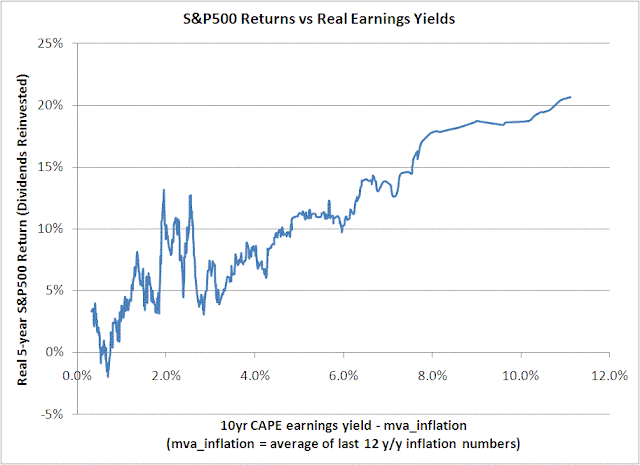The graph below shows an interesting trend. Here's how I built it. Take every month from January 1950 to October 2006 (5 years ago). For each month, compute the 10-year CAPE (Robert Shiller's 10-year PE ratio). The inverse of this number can be used as an earnings yield. Then subtract what I call the "moving average inflation" which is simply the average of the last 12 year-over-year monthly inflation readings using the CPI. This gives a sense of the premium above inflation that the CAPE is giving you for investing in the S&P 500. I plotted this against the forward 5-year real returns (with dividends re-invested) for the S&P 500. I smoothed the graph by taking a sliding average of 20 points (sorted on the x-axis value).
The trend is that as the CAPE goes down (real earnings yield goes up) relative to inflation, the forward 5 year real returns are higher. It has some zigs and zags in it, but the trend is fairly strong.
Today I believe the CAPE would be between 17 (5.9%) and 20 (5%). The moving average inflation is at 2.4%. So the earnings yield is between 2.6% and 3.5%. The graph implies an expected real return in the 5-6% range. Looking directly at the data points (without the 20-point moving average), the spread of the returns is from -11% to +28% in this 2.6%-3.5% range, with an average of 7% and median of 6%.
All in all, another argument that stocks are cheap when compared to the real returns you can expect from any other investment.
The trend is that as the CAPE goes down (real earnings yield goes up) relative to inflation, the forward 5 year real returns are higher. It has some zigs and zags in it, but the trend is fairly strong.
Today I believe the CAPE would be between 17 (5.9%) and 20 (5%). The moving average inflation is at 2.4%. So the earnings yield is between 2.6% and 3.5%. The graph implies an expected real return in the 5-6% range. Looking directly at the data points (without the 20-point moving average), the spread of the returns is from -11% to +28% in this 2.6%-3.5% range, with an average of 7% and median of 6%.
All in all, another argument that stocks are cheap when compared to the real returns you can expect from any other investment.

No comments:
Post a Comment